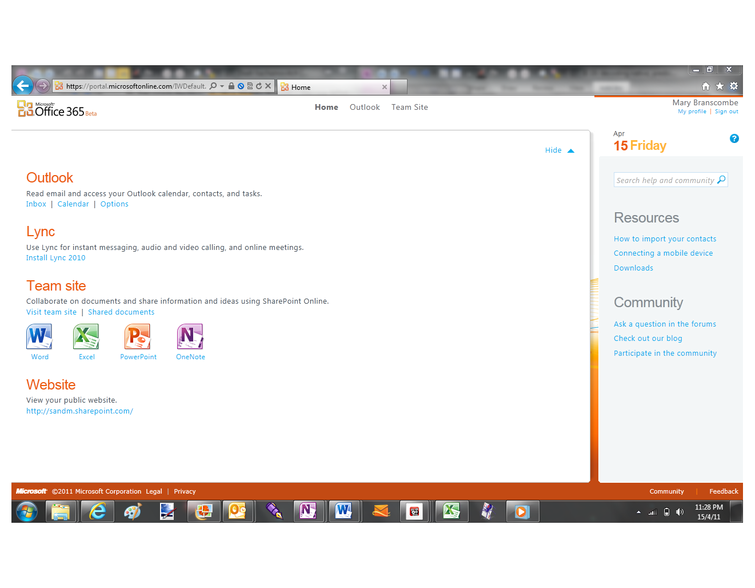Cloud computing is supposedly the future, but PCs and mobile devices have thus far remained overwhelmingly dependent on local hardware for data storage and processing. We’ve had to wait for Chrome OS to finally arrive – on the Samsung Chromebook Series 5 – for a product that embraces the concept in its purest form.
Chrome OS eschews local processing power in favour of online applications running through the Chrome web browser. Indeed, the browser is your only interface to the OS: it isn’t even possible to install other applications beyond browser plug-ins. It’s the web or nothing.
Living in the cloud
You may baulk at going without your regular desktop applications, but at the Chrome Web Store you’ll find web-based ways to achieve most computing tasks, as well as gateways to web content, downloadable themes and a good selection of games. These install as Chrome Apps – half-bookmarks, half-extensions that can not only take you directly to the relevant site but also install extra services in Chrome OS (see Hooking up).
And although the Chrome OS concept relies on an internet connection, many third-party applications can be used offline, using HTML 5’s new offline storage features. Offline versions of Gmail, Google Calendar and Google Docs are promised by late summer.
Strength in simplicity
The minimal model has several advantages. The OS boots in fewer than ten seconds – we timed 6.7 seconds to the login screen – and resumes from hibernation in two seconds flat, giving something close to the instant-on experience of a tablet.
The simple design also makes it easy for Google to trickle out frequent updates, as it does with the Chrome browser. It’s promised that every Chrome OS device will automatically gain new features over time, potentially including improvements to performance and battery life.
And because everything in Chrome OS runs within the browser, it’s sandboxed by default. Indeed, Google says the Chromebook needs no antivirus software – a bold claim, but one that’s backed up by a TPM-authenticated boot sequence. Certainly Chrome OS is far more difficult to hijack than Windows or OS X.
It’s arguably better for data security, too. Since your data lives in the cloud, you won’t lose it if your Chromebook is lost or stolen. All that’s held on the Chromebook’s tiny 16GB SSD is caches and settings – and even these are encrypted, so without your password a thief can’t access any information at all. You, meanwhile, can simply pick up another Chromebook, enter your credentials and carry on working.
There are downsides to the Chrome OS model, though, especially for business use. Transmitting your information back and forth leaves you vulnerable to packet-sniffing attacks; and should your host suffer a hacker attack, you’re helpless. A service outage could leave you unable to work at all. And we doubt IT departments will be keen to support a platform that automatically patches itself with no local management.
The hardware
The Chromebook Series 5 hardware adopts a simple design, to complement the new OS. The battery is internal, the RAM isn’t upgradeable and the hard disk isn’t accessible either – although you can get at the mSATA SSD slot if you unscrew the backplate.
Look around the edges and you’ll also notice there’s no wired Ethernet port, nor HDMI – only one mini-VGA output (the adapter is in the box), a single 3.5mm audio in/out socket and a SIM slot, enabling the 3G model to access a mobile internet connection. You get two USB 2 sockets and an SD card reader, but these aren’t as useful as you might expect (see Practicalities).
Turn to the keyboard and you’ll notice that, in place of function keys, the Chromebook has a row of navigation and control buttons. At the left, instead of Caps Lock, there’s a dedicated search key. The outsized trackpad measures a generous 116mm across the diagonal, allowing you to sweep across the full width of the screen in one movement. You can scroll up and down web pages with a two-finger drag, but Chrome OS doesn’t currently support swiping left and right to navigate between pages.
A final nice touch is the lid sensor: the Chromebook automatically powers on as soon as you open it up, and hibernates when you close it. It’s a little thing, but it helps the Chromebook feel quick and simple.
Hooking up
The Chromebook Series 5 has two USB ports; but there’s no way in Chrome OS to install new device drivers, so you can only connect pre-supported devices. That includes USB mice and keyboards, and approved wired Ethernet adapters. But you can forget about complicated items such as TV tuners or printers: if you want to print out a web page from Chrome OS, you’ll have to use Google’s roundabout Cloud Print service to send it via a different computer.
The main use for the USB sockets – such as the SD card slot, for example – is for connecting external storage. The Chrome OS file browser can view, play and queue the most common file types, including PDFs, pictures, music and videos, although high bit-rate HD files may stutter. Chrome Apps can also register services for specific file types: for example, once you’ve installed Picasa, the next time you connect a drive containing JPEG files, you’ll see the option to upload them to Picasa.
We found Chrome OS fussy about disk formats, though. NTFS volumes are officially supported, but only freshly formatted FAT32 media worked for us. And the browser is rudimentary: you can’t search, edit or organise your files without first uploading them to a remote service. Nor is there any way to connect to shared resources on your home network. It’s clear that, for Google, support for local files is a low priority.
The practicalities
Although the Chromebook is comparatively cheap, it feels like a high-quality laptop. Its slim chassis is sturdy and stylish, and the keyboard feels supremely spacious and solid. The matte 12.1in LED screen offers a comfortable 1,280 x 800 resolution, and a bright, sharp image – although colours are rather cold and muted.
And with its super-lightweight OS and 2GB of DDR3 RAM, the Chromebook feels terrifically snappy, scrolling around and flicking between browser tabs at lightning speed. The placement of the navigation keys at the top of the keyboard isn’t exactly convenient, but overall it’s a pleasure to use.
The Chromebook’s actual usefulness, though, depends on what you want to do. For basic web browsing, the screen and keyboard are perfect, and the built-in webcam and microphone make it suitable for VoIP and chat applications too.
Battery life isn’t bad, either: Samsung promises eight hours of light use, and one charge was enough to happily get us through a day of casual browsing, so long as we remembered to put the lid down between sessions. Impressively, we were able to enjoy just over five hours of full-screen iPlayer playback on a full charge, and although the Chromebook's integrated speakers are nowhere near hi-fi quality, they were loud and clear enough for us to enjoy the show. It all adds up to a tempting alternative to a regular netbook, for a modest price premium.
Limitations
For a more general-purpose role, though, the Chromebook is uncomfortable. It isn’t only the loss of physical ownership of your data that’s unnerving. The problem is that current web-based applications are almost invariably poor cousins of the desktop applications we’re used to: compare, for example, Microsoft’s web-based Office applications to their native counterparts, or even to the free LibreOffice suite. Chrome OS also lacks runtimes for Java or Silverlight. Working in Chrome OS thus ends up feeling like an endless series of compromises.
The Atom processor doesn’t help, either. Although the OS itself flies along, Flash games and in-browser videos tend to stutter. Angry Birds online won’t run smoothly in HD mode, YouTube struggles with 720p movies, and full-screen video from BBC iPlayer looks sticky even at standard definition. Browser benchmarks confirm that for any task more taxing than basic browsing, the Chromebook is precisely as ponderous as a regular Windows or Linux-based netbook.
A secondary source of unease is Chrome OS’s reliance on an internet connection. Google is negotiating a contract-free, pay-as-you-go data plan to accompany the 3G Chromebook, so you need never be out of coverage. But the smoothness of your experience will always depend on the speed and stability of your connection – not an idea that fills us with confidence, especially given the state of Britain’s 3G internet services.
And if you were thinking of dual-booting a more mainstream OS alongside Chrome OS, you may be out of luck: the Chromebook simply won’t boot from an external drive, at least not officially.
Verdict
The Chromebook hardware is a joy to use, and it’s exciting to see a new operating system take its first steps. But the overall package isn’t compelling enough to persuade us to give up our familiar applications and ways of working.
The platform certainly has potential. The usability gap between online and local applications is constantly dwindling, and Chrome OS itself will only get better.
Right now, though, the applications simply aren’t there to support the Chromebook – and nor, arguably, is the network coverage. In a year or two the Chromebook could make a very attractive personal computing platform, but for now we’d recommend you hold off.
































